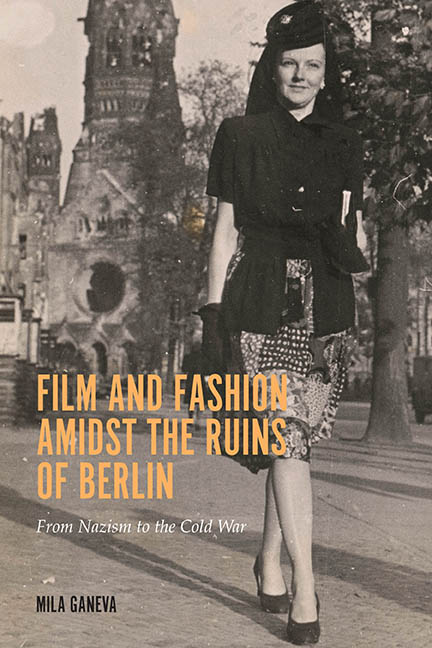Book contents
- Frontmatter
- Contents
- List of Illustrations
- Acknowledgments
- Introduction
- Chapter 1 Vicarious Consumption: Wartime Fashion in Film and the Press, 1939–44
- Chapter 2 “Fashions for Fräuleins”: The Rebirth of the Fashion Industry and Media in Berlin after 1945
- Vignette 1 Charlotte Glückstein: Historical Ruptures and Continuities in Postwar Fashion
- Chapter 3 Fashion amidst the Ruins: Revisiting Two Early Rubble Films,… und über uns der Himmel (1947) and Die Mörder sind unter uns (1946)
- Vignette 2 Hildegard Knef: Star Appeal from Fashion to Film
- Chapter 4 Farewell to the Rubble and Welcome to the New Look: Straßenbekanntschaft (1948) and Martina (1949)
- Chapter 5 Consuming Fashion on the Screens of the Early 1950s: Modell Bianka (1951), Frauenschicksale (1952), and Ingrid: Die Geschichte eines Fotomodells (1955)
- Epilogue
- Appendix 1 Principal Costume and Fashion Designers: Biographical Notes
- Appendix 2 Films and Newsreels Discussed
- Notes
- Bibliography
- Index
Introduction
Published online by Cambridge University Press: 28 July 2018
- Frontmatter
- Contents
- List of Illustrations
- Acknowledgments
- Introduction
- Chapter 1 Vicarious Consumption: Wartime Fashion in Film and the Press, 1939–44
- Chapter 2 “Fashions for Fräuleins”: The Rebirth of the Fashion Industry and Media in Berlin after 1945
- Vignette 1 Charlotte Glückstein: Historical Ruptures and Continuities in Postwar Fashion
- Chapter 3 Fashion amidst the Ruins: Revisiting Two Early Rubble Films,… und über uns der Himmel (1947) and Die Mörder sind unter uns (1946)
- Vignette 2 Hildegard Knef: Star Appeal from Fashion to Film
- Chapter 4 Farewell to the Rubble and Welcome to the New Look: Straßenbekanntschaft (1948) and Martina (1949)
- Chapter 5 Consuming Fashion on the Screens of the Early 1950s: Modell Bianka (1951), Frauenschicksale (1952), and Ingrid: Die Geschichte eines Fotomodells (1955)
- Epilogue
- Appendix 1 Principal Costume and Fashion Designers: Biographical Notes
- Appendix 2 Films and Newsreels Discussed
- Notes
- Bibliography
- Index
Summary
IN A FICTION FILM that premiered in 1948 and was shown in both West and East Berlin, Vor uns liegt das Leben (Life Lies before Us, directed by Günther Rittau), a piece of textile plays a central role in a tragicomical subplot. The wife, Renate Harms, played by Helga Zülch, has stashed away some fine fabric from before the war. She travels to the countryside and trades it to a peasant woman for a goat so that her child will have some milk. The peasant woman wraps herself in the cloth, swirls indulgingly in front of the mirror, and admires the quality of the newly obtained treasure. “Friedensqualität!” (Peacetime quality!) she exclaims and is happy about the shrewd deal that she has just made. At the same time, Captain Harms (Hermann Speelmans), not aware of his wife's trade, arranges to sell his treasured model ship to a black-market dealer in order to buy that same piece of fabric from the peasant woman's husband. It is meant to be a surprise present for Renate, so that she will have a warm winter coat, something she desperately needs.
This small story from a now-forgotten early postwar German film encapsulates the harsh experiences of ordinary civilians in the transition years from 1945 to 1949, experiences marked by hunger and cold, rations and depravity, self-sacrifice and hope, hard physical labor and predatory black-market deals. It complements poignant earlier sequences in the film that feature women with ration cards in their hands, waiting in long lines to obtain sacks of potatoes. The culture of deficits even offers realistic glimpses of the dynamics of postwar relationships within the family as well as the relationship between cities and the countryside. The visual narrative around the piece of fabric also hints at how clothing items and even scraps of textile became extremely necessary for survival within this context: they were seen as valuable barter items to exchange for food, the objects of dreams, nostalgic traces of a lost past, and hopeful signs of a future normalization of life.
If one dares to talk at all about fashion in the immediate aftermath of the war—something the journalist Marietta Riederer considered “grotesque” — then the term “fashion” (Mode) inevitably refers to various creative practices of bartering, mending, and making do with what was available. “Everyone put on whatever they had left.
- Type
- Chapter
- Information
- Film and Fashion amidst the Ruins of BerlinFrom Nazism to the Cold War, pp. 1 - 20Publisher: Boydell & BrewerPrint publication year: 2018

